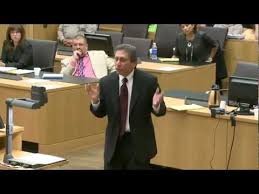Cross-Examinations in the Jodi Arias Trial
 With all the attention on the Jodi Arias trial, I think it is worthwhile to identify good and bad trial practices. I will try to refrain from lengthy criticisms but there are some points to be made.
With all the attention on the Jodi Arias trial, I think it is worthwhile to identify good and bad trial practices. I will try to refrain from lengthy criticisms but there are some points to be made.
If anyone thinks the Jodi Arias trial is a sterling example of a criminal trial in our justice system, they are surely mistaken. Much of the questioning, on both sides, is misguided and improper, with little regard to an overall trial strategy. As a former prosecutor, my sympathies lie with Juan Martinez, who has had some excellent moments. The defense, on the other hand, has violated so many basic rules of cross-examination, it is hard to see anything positive.
Let’s go thru some basic rules of cross-examination as applied in the Arias case.
First, cross-examination in most cases must be short, to the point, and completed with authority. With the exception of a star government witness or a defendant, cross-examination of each witness should last no longer than a few hours. Days and days of cross-examination are untenable and should be stopped by the trial judge. Moreover, the questioner is sure to lose the attention of the jury. A questioner needs to know when to sit down after making his or her points. No one is Perry Mason and there are very few moments in real life like the Perry Mason trials.
Second, we all have heard the rule that no one should ask a question unless they know the answer. That is generally true; however, on occasion there are times to ask open-ended questions when any answer will help your case.
Third, cross-examination should never reinforce the direct testimony of a witness. This rule has been violated over and over by both sides leading to repetitive questioning, and loss of focus. Such practices give a witness opportunities to reiterate points made on direct and reflect poor cross-examination strategy.
Fourth, cross-examination should be used to “speak” to the jury – meaning, that the questioner does not care about the answer by the witness, but is asking a question which the witness will deny but nonetheless tells the jury what the questioner thinks about the specific point.
Fifth, use the trial judge to help your cross-examination. Prosecutor Martinez is very effective in using the trial judge to direct a witness to respond to a question rather than providing a non-responsive broad explanation.
 Sixth, when you have a witness caught in a misrepresentation or lie – drive the point home. Prosecutor Martinez had the defense witness LaViolette caught in a misrepresentation – she stated she had testified on behalf of a male defendant in criminal court 1-2 times. On cross-examination, Martinez effectively got her to admit that she did not testify but only submitted a report. A great moment!!! Did he drive the point home? No, he stopped for some inexplicable reason. He could have pursued her, questioned other parts of her testimony and repeated her misrepresentation to the jury – she lied in response to a juror question.
Sixth, when you have a witness caught in a misrepresentation or lie – drive the point home. Prosecutor Martinez had the defense witness LaViolette caught in a misrepresentation – she stated she had testified on behalf of a male defendant in criminal court 1-2 times. On cross-examination, Martinez effectively got her to admit that she did not testify but only submitted a report. A great moment!!! Did he drive the point home? No, he stopped for some inexplicable reason. He could have pursued her, questioned other parts of her testimony and repeated her misrepresentation to the jury – she lied in response to a juror question.
Trial strategy requires persistence, a little bit of dramatic flair and knowing how to act in response to specific situations. Juries can pick up on many trial subtleties – they watch, learn and have a feel for the parties. Knowing how to cross-examine a witness is a skill which depends on quick thinking and experience.
















Interesting points… From a European point of view the jury systems feels a bit “odd”. Somehow it all depends on the actor skills (defendant) or the councils… Tells question: is there true justice if ordinary people are involved in the decision process?
Great post. As a complete layperson when it comes to trials, I’ve wondered why the judge has let both sides ramble on and on for hours or days. I’m sure they’ve lost the jury several times by now!